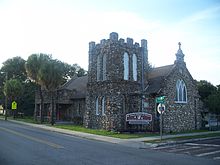
The Episcopal Diocese of Washington is a diocese of the Episcopal Church covering Washington, D.C. and nearby counties of Maryland in the United States. With a membership of over 38,000, the diocese is led by the Bishop of Washington, Mariann Budde. It is home to Washington National Cathedral, which is the seat of both the diocesan bishop and the Presiding Bishop of the Episcopal Church.
Seminole Heights is a historic neighborhood and district located in central Tampa. It includes many early 20th century bungalow homes and historic buildings. It was an early residential area of Tampa connected by streetcar. The area had an economic downturn in the late 20th century marked by increased crime, but has since seen a resurgence with new restaurants, brew pubs and independent businesses opening up. The neighborhood's historic homes, eclectic shops and gourmet restaurants are an increasing draw.
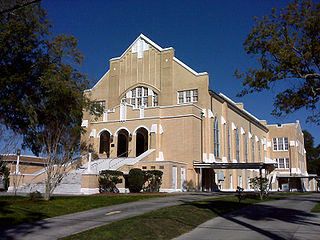
Seminole Heights United Methodist Church, also referred to as Seminole Heights Methodist or Seminole Heights UMC, is an active Methodist congregation and a historic, Gothic Revival style church building constructed in 1927 in the Old Seminole Heights neighborhood of Tampa, Florida. The building is one of the contributing structures within the Seminole Heights Residential District, a U.S. National and Local Historic District. Seminole Heights United Methodist Church is located at 6111 Central Avenue, at the southeast corner of the intersection of Central and Hanna Avenues.

The Seminole Heights Residential District, known also as the Seminole Heights Historic District, is a U.S. and Local Historic District located in Tampa, Florida. The district is roughly bounded by Hanna Avenue to the north, Cherokee Avenue and I-275 to the east, Florida Avenue to the west, and Osborne Avenue to the south.

Chapel of the Cross is a parish of the Episcopal Church of the United States in Chapel Hill in the Diocese of North Carolina. It is the spiritual home to more than 1,600 communicants, including numerous students studying at the University of North Carolina at Chapel Hill.

The United Episcopal Church of North America (UECNA) is a church in the Anglican tradition and is part of the Continuing Anglican movement. It is not part of the Anglican Communion.

The Church of St. James the Less is a historic Episcopal church in Philadelphia, Pennsylvania, that was architecturally influential. As St. James-the-Less Episcopal Church, it was designated a National Historic Landmark for its Gothic Revival architecture, which influenced a generation of subsequent churches.

The Episcopal Diocese of Florida is a diocese of the Episcopal Church in the United States of America (ECUSA). It originally comprised the whole state of Florida, but is now bounded on the west by the Apalachicola River, on the north by the Georgia state line, on the east by the Atlantic Ocean and on the south by the northern boundaries of Volusia, Marion, and Citrus counties. Its cathedral church is St. John's Cathedral in Jacksonville.

The Episcopal Diocese of Southwest Florida is a diocese of the Episcopal Church in the United States of America (ECUSA) in Florida which extends from Marco Island on the south, to Brooksville on the north, and inland to Plant City, Arcadia and LaBelle on the east. As part of the ECUSA, the diocese is a constituent member of the worldwide Anglican Communion.

Sacred Heart Catholic Church was constructed in 1905 in downtown Tampa, Florida and is one of the oldest churches in the city of Tampa. The church, located at 509 N. Florida Avenue, is predominantly a Romanesque structure, with other elements. The church is home to Sacred Heart Parish, part of the West Hillsborough Deanery of the Roman Catholic Diocese of Saint Petersburg.

St. Agatha's Episcopal Church is a historic Carpenter Gothic Episcopal church located at 144 Circle Drive, in DeFuniak Springs, Florida in the United States. It is a contributing property in the DeFuniak Springs Historic District.

St. James' Episcopal Church, named for James the Greater, is a historic Episcopal church located in Manitowoc, Wisconsin. The only Episcopal church in Manitowoc County, St. James' is a "broad church" parish in the Diocese of Fond du Lac. It is the oldest continually operating congregation in Manitowoc County, first meeting in 1841. and organizing in 1848. The current church building, an example of Gothic Revival architecture, was consecrated in 1902. The congregation is active in community service and social justice ministries.
Old Seminole Heights is a neighborhood within the city limits of Tampa, in the U.S. state of Florida. The neighborhood is one of three which comprise the greater Seminole Heights district within the city. As of the 2010 census the neighborhood had a population of 14,729. The ZIP Codes serving the area are 33603, 33604, and 33610.

St. Andrew's Episcopal Church is an active Episcopal parish and historic church building in Tampa, Florida, United States. The structure is located downtown at 505 North Marion Street, however, the parish offices are located at 509 East Twiggs Street. On April 15, 2009, the church building was added to the U.S. National Register of Historic Places (NRHP). Francis J. Kennard and Michael J. Miller are credited as the building's architects.

The Church of Our Saviour is a historic Episcopal parish in the village of Mechanicsburg, Ohio, United States. Founded in the 1890s, it is one of the youngest congregations in the village, but its Gothic Revival-style church building that was constructed soon after the parish's creation has been named a historic site.

St. Andrew's Episcopal Church is located at North Main and Madison avenues in Albany, New York, United States. It is a complex of three buildings, centered on the church itself, a stone structure designed by architect Norman Sturgis in the Late Gothic Revival architectural style and built in 1930. In 2005 it was listed on the National Register of Historic Places.
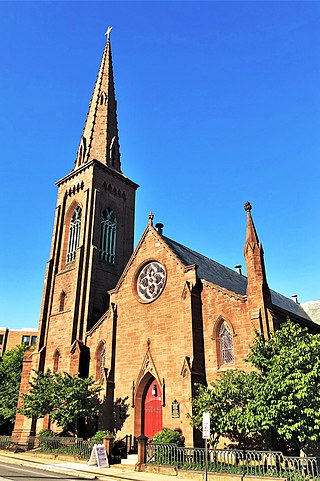
St. James Episcopal Church at 76 Federal Street at the corner of Huntington Street in New London, Connecticut is a historic church in the Episcopal Diocese of Connecticut. The congregation was founded in 1725, and the current church – the congregation's third – was built from 1847 to 1850 to designs in the Gothic Revival style by Richard Upjohn.
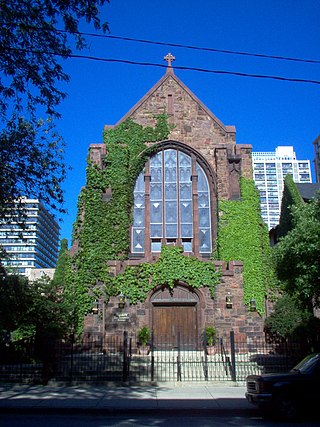
The Episcopal Church of the Atonement and Parish House is a historic church building at 5751 North Kenmore Avenue in Chicago, Illinois. The Gothic Revival building was constructed in 1889 and added to the National Register of Historic Places in 2009.
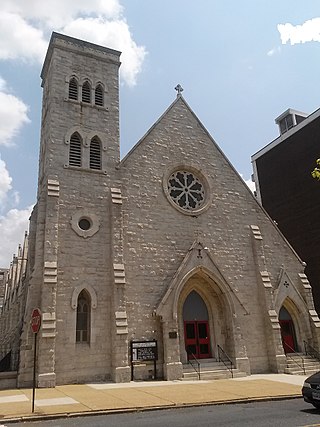
St. James Episcopal Church Lafayette Square, or St. James African Episcopal Church, founded in 1824, is a historic Episcopal church now located at 1024 W. Lafayette Avenue in the Lafayette Square Historic District of Baltimore, Maryland.
St. Luke's Episcopal Church, formerly known as Hope Episcopal Church, is an historic church building located in Fort Madison, Iowa, United States. It is a parish church of the Episcopal Diocese of Iowa, and it is a contributing property in the Park-to-Park Residential Historic District listed on the National Register of Historic Places.
